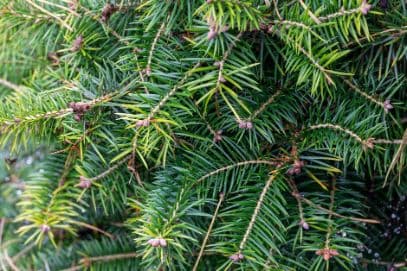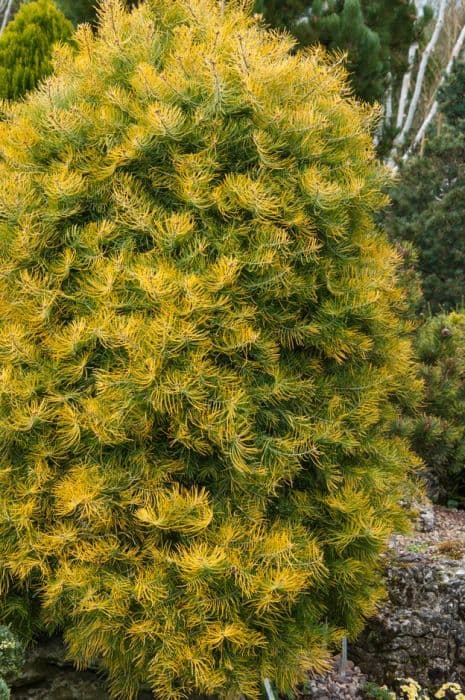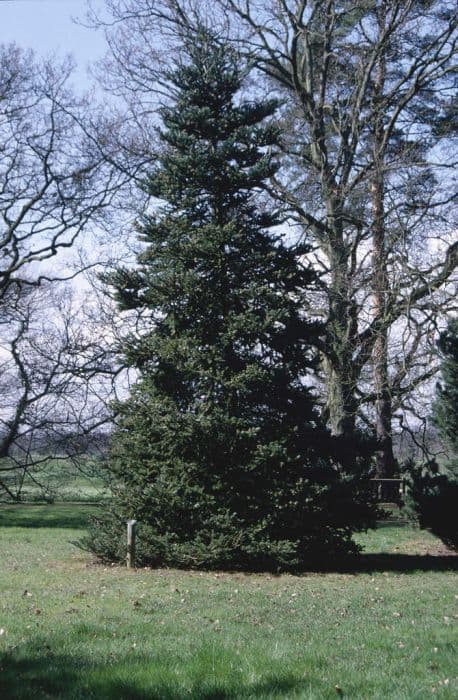Dwarf Japanese Larch Larix kaempferi 'Nana' Neumann

ABOUT
The Japanese Larch 'Nana' is a dwarf conifer with a distinctly rounded, compact shape. The foliage, which changes with the seasons, consists of soft, bright green needles that emerge in spring. As summer progresses, the green deepens, and in autumn, the needles turn a striking golden yellow before falling off, as this conifer is deciduous, shedding its needles annually. The small cones that develop are initially light green, maturing to a deeper brown color as they age. Throughout its growth, the plant maintains a dense, bushy appearance, making it a charming addition to garden landscapes. The bark is an attractive feature as well, with a rough texture and a reddish-brown color that provides visual interest even in winter months when the plant is without its foliage.
About this plant
 Names
NamesFamily
Pinaceae
Synonyms
Dwarf Japanese Larch, Nana Japanese Larch
Common names
Larix kaempferi 'Nana' Neumann.
 Toxicity
ToxicityTo humans
The plant commonly known as Japanese larch is not known to be toxic to humans. There are no well-documented cases of poisoning or toxicity affecting humans from ingesting or handling this plant. However, it's always a good practice to avoid ingesting plant material that is not meant for consumption as individual allergies or sensitivities could potentially cause adverse reactions.
To pets
The Japanese larch is not specifically listed as toxic to pets. However, as with humans, it is generally advisable not to let pets consume plants that are not intended for their diet. Ingesting non-food plants can sometimes lead to gastrointestinal upset in pets, such as vomiting or diarrhea, simply due to the plant material being indigestible or irritating to the pet's system, rather than an inherent toxicity of the plant.
 Characteristics
CharacteristicsLife cycle
Perennials
Foliage type
Deciduous
Color of leaves
Green
Height
3 feet [0.91 meters]
Spread
3 feet [0.91 meters]
Plant type
Tree
Hardiness zones
5
Native area
Japan
Benefits
 General Benefits
General Benefits- Compact Growth: Larix kaempferi 'Nana' is a dwarf cultivar, which makes it suitable for smaller gardens or limited spaces.
- Ornamental Appeal: With its attractive conical shape and bright green foliage that turns golden in autumn, it provides year-round visual interest.
- Low Maintenance: This plant requires minimal pruning or other care once established, making it an easy choice for both novice and experienced gardeners.
- Cold Tolerant: It can withstand cold temperatures, ideal for cooler climates or high-altitude gardens.
- Drought Resistance: Once established, it is relatively drought-tolerant, reducing the need for frequent watering.
- Wildlife Habitat: Can serve as a habitat for birds and other wildlife, offering shelter and sometimes food.
- Soil Versatility: Adaptable to a range of soil types, although it prefers well-drained soil conditions.
 Medical Properties
Medical PropertiesThis plant is not used for medical purposes.
 Air-purifying Qualities
Air-purifying QualitiesThis plant is not specifically known for air purifying qualities.
 Other Uses
Other Uses- Larix kaempferi 'Nana', also known as the Dwarf Japanese Larch, can be used in bonsai cultivation due to its miniaturized growth habit and attractive conical shape.
- The dense foliage of the Dwarf Japanese Larch offers a unique textural contrast in rock gardens, creating an alpine landscape aesthetic.
- Its slow growth and compact form make it suitable for use in small garden containers or terrace gardens where space is limited.
- Being tolerant of cold, the plant works well in designs for winter gardens, especially since it retains an interesting form even after its needles have dropped.
- The contrast between the new bright green spring growth and the old golden yellow needles in the fall can be harnessed for seasonal garden interest.
- Because of its shape and needle-like leaves, the Dwarf Japanese Larch can be used in fairy gardens to create a woodland fantasy setting.
- The plant's resistance to pests and diseases allows it to be used in low-maintenance plantings where less care is preferred or feasible.
- The unique texture of the needles can be used in sensory gardens, which are designed to stimulate the senses through plant characteristics.
- The Dwarf Japanese Larch is an excellent candidate for holiday decorations, where its evergreen appearance can contribute to festive displays.
- The plant's ability to grow in a variety of soil types, including poor soils, makes it suitable for erosion control in challenging garden spots.
Interesting Facts
 Feng Shui
Feng ShuiThe Japanese Larch is not used in Feng Shui practice.
 Zodiac Sign Compitability
Zodiac Sign CompitabilityThe Japanese Larch is not used in astrology practice.
 Plant Symbolism
Plant Symbolism- Resilience: Larix kaempferi 'Nana', commonly known as Japanese Larch, is a deciduous conifer that can withstand cold temperatures and represents resilience and perseverance through harsh conditions.
- Rebirth: As a deciduous conifer, the Japanese Larch sheds its needles in the fall and regrows them in spring, symbolizing renewal and the circle of life.
- Transformation: The tree's ability to change with the seasons reflects the theme of transformation and adaptability to changing circumstances.
- Eternal Life: With its evergreen relatives, the Japanese Larch carries a connotation of immortality and eternal life, despite its own deciduous nature.
- Peace: The soft, green needles and the tree's association with serene Japanese landscapes can symbolize tranquility and peace.
 Water
WaterThe Dwarf Japanese Larch (Larix kaempferi 'Nana') should be watered regularly to maintain a consistently moist soil environment, especially during its growing season in spring and summer. It's best to water deeply once a week, providing about 1-2 gallons of water each time, depending on the size of the plant and the weather conditions. In hotter, dryer periods, more frequent watering may be necessary to prevent the soil from drying out. During the winter months, reduce watering as the plant's water requirements decrease.
 Light
LightThe Dwarf Japanese Larch thrives in full sun, meaning it needs at least 6 hours of direct sunlight daily. An ideal spot would be in an open garden or yard where it's exposed to unfiltered sunlight for most of the day. This species can tolerate some light shade, but too much shade can lead to sparse growth and reduced vigor.
 Temperature
TemperatureThe Dwarf Japanese Larch can survive in temperatures as low as -30°F and as high as about 90°F. However, the ideal temperature range for this plant is between 60°F and 75°F. The Dwarf Japanese Larch is quite cold-hardy and adapts well to seasonal changes typical of temperate climates.
 Pruning
PruningPrune your Dwarf Japanese Larch to maintain shape and remove any dead or damaged branches. The best time for pruning is in late winter or early spring before new growth starts. Light pruning can be done annually, but significant shaping should be done infrequently, as the plant generally maintains a good shape naturally.
 Cleaning
CleaningAs needed
 Soil
SoilThe Japanese Larch 'Nana' prefers a well-draining acidic to neutral soil mix, with a pH range of 5.5 to 7.0. Incorporate organic matter such as peat moss or compost to ensure good drainage and fertility, and consider adding pumice or perlite to enhance aeration. Ensure that the soil mix retains moisture without becoming waterlogged to promote healthy root growth.
 Repotting
RepottingJapanese Larch 'Nana' should be repotted every 2 to 3 years to encourage healthy growth. Younger plants may need more frequent repotting, while older, established plants can be repotted less often. It's best to repot in early spring, before the onset of new growth, to minimize stress to the plant.
 Humidity & Misting
Humidity & MistingJapanese Larch 'Nana' thrives in moderate to high humidity levels but is adaptable to various humidity conditions outdoors. To maintain optimal health and foliage, aim for humidity levels above 50%. In an indoor setting, it may benefit from occasional misting or a nearby humidifier to replicate its preferred environment.
 Suitable locations
Suitable locationsIndoor
Place in bright, indirect light and ensure good air circulation.
Outdoor
Plant in full sun; shelter from harsh winds; well-draining soil.
Hardiness zone
5-7 USDA
 Life cycle
Life cycleLarix kaempferi 'Nana', also known as Dwarf Japanese Larch, begins its life as a seed, which after stratification, germinates in the spring. The seedling then grows and develops into a young plant, exhibiting rapid growth in its early years and forming a dense, conical shape. As the dwarf shrub matures, it reaches a height and width of typically 3-5 feet, much smaller than the species norm, and maintains a well-rounded, compact form. Throughout the years, the Dwarf Japanese Larch produces needle-like leaves that are bright green in spring, turning golden yellow in autumn before they are shed, as it is a deciduous conifer. The plant reaches reproductive maturity and starts producing cones after a few years, with small, rounded female cones and elongated male cones that release pollen. The Dwarf Japanese Larch can live for several decades, after which it will eventually decline in health and die, completing its life cycle.
 Propogation
PropogationPropogation time
Spring-Early Summer
Propogation: The Japanese Larch 'Nana', scientifically known as Larix kaempferi 'Nana' Neumann, can be propagated through softwood cuttings. This method is often considered the most popular and is typically conducted in late spring to early summer. To propagate, cuttings of about 4 to 6 inches (10 to 15 centimeters) are taken from the current year's growth. The lower needles should be removed, and the cut end dipped in rooting hormone to facilitate root development. The prepared cuttings are then placed in a well-draining soil mix and kept consistently moist under a humidity dome or in a propagator to maintain high humidity. It is crucial to provide the cuttings with warmth and indirect sunlight until rooting occurs, which often takes a few weeks to a couple of months, after which they can be gradually acclimated to outdoor conditions.









